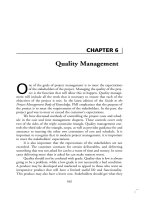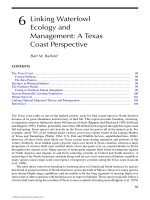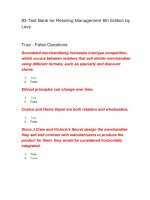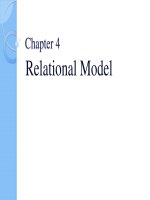Lecture Retailing management (6/e): Chapter 6 - Levy Weitz
Bạn đang xem bản rút gọn của tài liệu. Xem và tải ngay bản đầy đủ của tài liệu tại đây (1.22 MB, 48 trang )
����������������������������������������������������������������������������������������������������������������������������������������������������������������������������������������������������������������������������������������������������������������������������������������������������������������������������������������������������������������������������������������������������������������������������������������������������������������������������������������������������������������������������������������������������������������������������������������������������������������������������������������������������������������������������������������������������������������������������������������������������������������������������������������������������������������������������������������������������������������������������������������������������������������������������������������������������������������������������������������������������������������������������������������������������������������������������������������������������������������������������������������������������������������������������������������������������������������������������������������������������������������������������������������������������������������������������������������������������������������������������������������������������������������������������������������������������������������������������������������������������������������������������������������������������������������������������������������������������������������������������������������������������������������������������������������������������������������������������������������������������������������������������������������������������������������������������������������������������������������������������������������������������������������������������������������������������������������������������������������������������������������������������������������������������������������������������������������������������������������������������������������������������������������������������������������������������������������������������������������������������������������������������������������������������������������������������������������������������������������������������������������������������������������������������������������������������������������������������������������������������������������������������������������������������������������������������������������������������������������������������������������������������������������������������������������������������������������������������������������������������������������������������������������������������������������������������������������������������������������������������������������������������������������������������������������������������������������������������������������������������������������������������������������������������������������������������������������������������������������������������������������������������������������������������������������������������������������������������������������������������������������������������������������������������������������������������������������������������������������������������������������������������������������������������������������������������������������������������������������������������������������������������������������������������������������������������������������������������������������������������������������������������������������������������������������������������������������������������������������������������������������������������������������������������������������������������������������������������������������������������������������������������������������������������������������������������������������������������������������������������������������������������������������������������������������������������������������������������������������������������������������������������������������������������������������������������������������������������������������������������������������
Stores:
$350,000
$700,000
GiftstoGo.com $220,000
$440,000
=
50%
=
50%
626
Operating Expense Percent
Operating Expenses
Net Sales
Stores:
= Operating Expenses %
$250,000
$700,000
GiftstoGo.com: $150,000
$440,000
=
35.7%
34.1%
627
Net Profit Percentage
Net Profit = Net Profit Percentage
Net Sales
Stores:
$ 59,800
$700,000
=
8.5%
GiftstoGo.com:
$ 45,500
$440,000
=
10.3%
628
629
Balance Sheet Information for Gifts to Go
and Proposed Internet Channel
Inventory Turnover
Cost of Goods =
Average Inventory
Inventory Turnover
Stores:
$350,000
$175,000
=
2.0
GiftstoGo.com:
$220,000
$ 70,000
=
3.1
630
Asset Turnover
Net Sales =
Total Assets
Stores:
Asset Turnover
$700,000
$380,000
GiftstoGo.com: $440,000
$211,000
= 1.84
= 2.09
631
Return on Assets
632
Net Profit Margin x Asset Turnover = Return on Assets
Stores:
8.54
Giststgo.com 10.3
x
x
1.84
2.09
= 15.7%
= 21.3%
633
The Strategic Profit Model
Net Sales
Cost of
goods sold
Gross
margin
Variable
expenses
+
Fixed
expenses
Total
expenses
Profit Management
Net profit
Net profit
margin
Net Sales
x
Inventory
Net sales
+
Accounts
receivable
Total current
assets
+
+
Other current
assets
Fixed assets
Return on
assets
Asset
turnover
Total assets
Asset Management
Productivity Measures
Input Measures – assess the amount of resources or
money used by the retailer to achieve outputs such as
sales
Output measures – asses the results of a retailer’s
investment decisions
Productivity measure – determines how effectively
retailers use their resource – what return they get on their
investments
634
Setting and Measuring Performance
Objectives
Retailers will be better able to gauge performance if it has
specific objectives in mind to compare performance.
Should include:
• numerical index of performance desired
• time frame for performance
• necessary resources to achieve objectives
635
636
Setting Objectives in Large Retail Organizations
Top Down Planning
Corporate Developmental Strategy
Category, Departments
and sales associates
implement strategy
637
Setting Objectives in Large Retail Organizations
Corporate
Bottom Up Planning
Buyers and Store
managers estimate
what they can
achieve
Operation managers
must be involved in
objective setting
process
Financial Performance of Retailers
Outputs - Performance
• Sales
• Profits
• Cash flow
• Growth in sales,
profits – Same store
sales growth
638
Inputs Used by Retailers
• Inventory ($)
• Real Estate (sq. ft.)
• Employees (#)
• Overhead (Corporate
Staff and Expenses)
• Advertising
• Energy Costs
• MIS expenses
Productivity - Outputs/Input
• Corporate Level
– ROA = Profits/Assets (ROE = Profit/Equity)
– Overhead/Sales
• Buyers (Inventory, Pricing, Advertising)
– Gross Margin % = Gross Margin/Sales
– Inv Turnover = COGS/ Avg. Inventory (cost)
• GMROI – Gross Margin/Average Inventory
– Advertising/sales
• Stores (Real Estate, Employees)
– Sales/Square Feet inv. Shrinkage/sales
– Sales/Employee
639
Performance Objectives and Measures
Used by Retailers
640
Examples of Performance
Measures Used by Retailers
Level of
Output
Input
Organization
Productivity
(Output/Input)
Corporate
Net sales
(measures of
entire corporation)
Net profits
Growth in sales,
profits
Square feet of
store space
Return on assets
Number of
employees
Asset turnover
Inventory
Sales per employee
Advertising
expenditures
Sales per square
foot
641
Examples of Performance
Measures Used by Retailers
Level of
Output
Input
Organization
Merchandise
management
(measures for a
merchandise
category)
Productivity
(Output/Input)
Net sales
Inventory level
Gross Margin
Return on
Investment (GMROI)
Gross margin
Markdowns
Inventory turnover
Growth in sales
Advertising
expenses
Advertising as a
percentage of
sales *
Cost of
merchandise
Markdown as a
percentage of
sales*
* These productivity measures are commonly expressed as an input/output.
642
Examples of Performance
Measures Used by Retailers
Level of
Output
Input
Organization
Store operations
(measures for a
store or
department
within a store)
Productivity
(Output/Input)
Net sales
Square feet of
selling areas
Net sales per
square foot
Gross margin
Expenses for
utilities
Net sales per
sales associate
or per selling hour
Growth in sales
Number of sales
associates
Utility expenses as
a percentage of
sales *
* These productivity measures are commonly expressed as an input/output.
643
Illustrative Productivity Measures
Used by Retailing Organizations
Level of
Output
Input
Organization
Productivity
(Output/Input)
Corporate
(chief executive
officer)
Net profit
Owners’ equity
Net profit /
owners’ equity =
return on owners’
equity
Merchandising
(merchandise
manager and
buyer)
Gross margin
Inventory *
Gross margin /
inventory* =
GMROI
Square foot
Net sales /
square foot
Store operations Net sales
(director of stores,
store manager)
*Inventory = Average inventory at cost
644
Benchmarks
Performance of retailer over time – retailer
can compare its recent performance to its
performance in the preceding months,
quarters or years.
Performance of a retailer compared to its
competitors
645
Sources of Information
646
• Balance Sheet (Snap Shot at One Time)
– Asset Management
• Income Statement (Summary Over Time)
– Margin Management
• Annual Reports/ SEC Filings
– http://
www.sec.gov/edgar/searchedgar/companysearch
Federated’s and Costco’s Financial
Performance Over Three Years
647
648
Financial Performance of Federated and
Other National Department Store Chains









